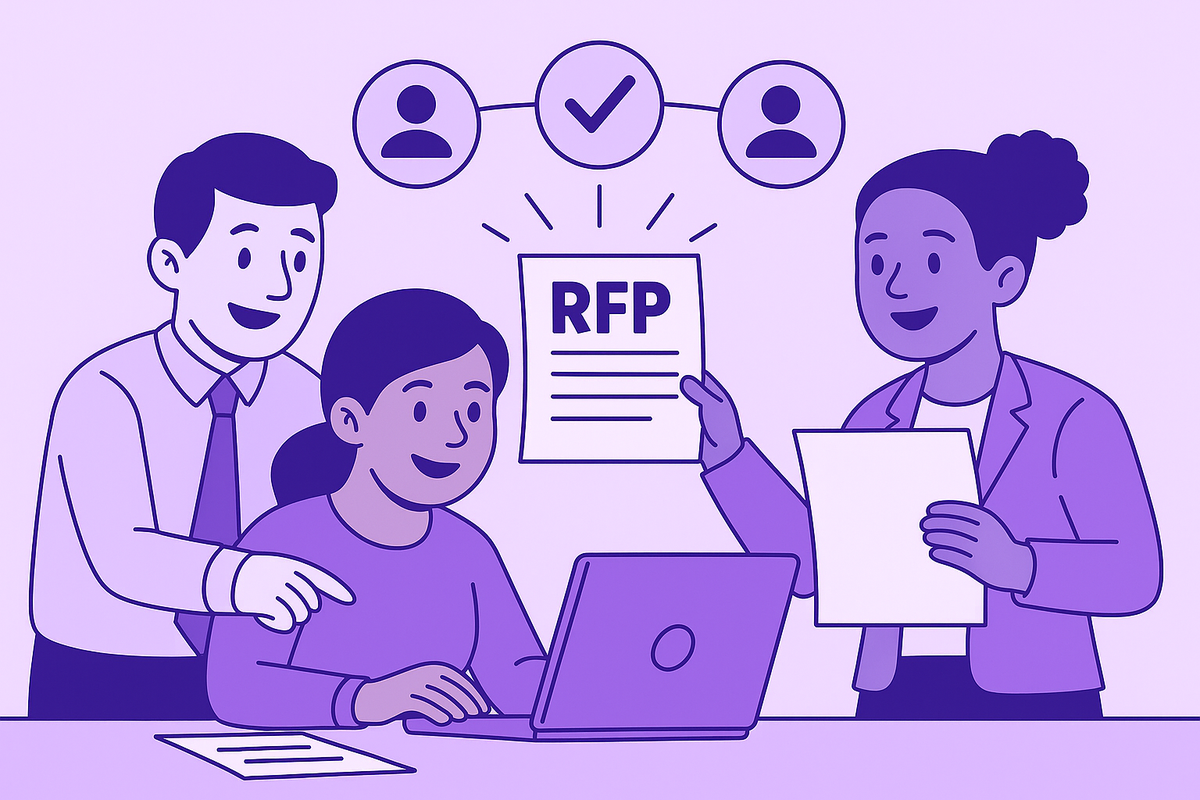What Are DDQs? A Simple Guide for Sales Teams
November 11, 2025
By
Evie Secilmis

Responding to a Due Diligence Questionnaire often feels like a company-wide fire drill. You’re suddenly tasked with coordinating across legal, finance, and IT, chasing down subject matter experts for answers you hope are still up-to-date. The process is manual, repetitive, and a major drain on resources that could be focused on revenue-generating activities. These comprehensive ddqs are a standard part of doing business, but the way you handle them doesn't have to be a chaotic scramble. With the right strategy and tools, you can create a repeatable, efficient workflow that ensures every response is accurate, consistent, and professional, helping you close deals faster.
Key Takeaways
- Treat a DDQ as a final trust-building step: A DDQ is a risk assessment, not a sales pitch. Use it as an opportunity to prove your company's reliability by providing transparent, accurate answers about your operations, security, and financial health.
- Establish a central knowledge base: Answering the same questions repeatedly is inefficient and introduces risk. Create a single source of truth with pre-approved content to ensure your responses are always consistent, accurate, and quick to assemble.
- Leverage technology to accelerate the process: Manual DDQ management slows down sales cycles. Adopt an AI-powered platform to automate response generation and centralize collaboration, allowing your team to complete questionnaires faster and focus on closing deals.
What is a Due Diligence Questionnaire (DDQ)?
Think of a Due Diligence Questionnaire (DDQ) as a detailed background check for a business. Before a company enters a significant partnership, makes an investment, or signs a major contract, they need to know exactly who they’re getting into business with. The DDQ is a formal document they send over, filled with specific questions designed to get a complete picture of an organization's health, operations, and potential risks. It’s their way of looking under the hood to make sure everything is in order.
For sales teams, responding to a DDQ is a critical step in the late stages of a deal. It’s your opportunity to build trust and prove that your company is stable, secure, and reliable. While it can feel like a mountain of paperwork, a well-crafted response can be the final piece that closes the deal. The goal is to provide transparent, accurate, and comprehensive answers that give the prospective client or partner the confidence they need to move forward. An AI-powered platform can help you manage this process by centralizing information and generating consistent, accurate first drafts.
Why businesses use them
Businesses use DDQs for one primary reason: to manage risk. Every new vendor, partner, or investment carries a certain level of uncertainty. A DDQ is a systematic way to uncover and assess potential red flags before any contracts are signed. It helps the issuing company understand if your business has any financial instability, legal troubles, or security vulnerabilities that could cause problems down the line.
The main goal is to streamline the disclosure process and make an informed decision. By asking detailed questions upfront, companies can identify risks before they become costly issues. This is a core part of third-party risk management, ensuring that any new relationship won't jeopardize their operations, finances, or reputation.
What a DDQ includes
A DDQ is designed to be thorough, so it covers a wide range of topics to create a complete business snapshot. You can expect questions that touch on nearly every department in your company. The goal is to gather detailed information that paints a full picture of your organization’s operational and financial standing. While the specifics can vary, most DDQs dig into several critical areas.
You’ll need to provide information on your company’s financial health, legal and compliance history, operational processes, and intellectual property. Increasingly, you’ll also see deep dives into cybersecurity measures and data privacy policies. Having the right features in your response software is key to pulling this information from across the company and ensuring every answer is up-to-date and accurate.
Why DDQs Are Key to Managing Risk
Think of a DDQ as more than just another form to fill out. It’s a powerful tool that businesses use to look before they leap into a new partnership, investment, or major transaction. By asking the right questions upfront, companies can uncover potential issues and make smarter, safer decisions. Here’s how DDQs play a crucial role in managing risk.
Protect your bottom line
At its core, a DDQ is about protecting the company's financial health. A Due Diligence Questionnaire is a structured document used to assess the risk associated with a new business relationship. By identifying potential red flags early, organizations can make informed decisions that protect their financial interests. Imagine discovering a potential partner has a history of lawsuits or is on shaky financial ground after you’ve signed a contract. A thorough DDQ helps you spot these issues beforehand, preventing costly disputes, operational disruptions, and deals that could drain your resources. It’s a proactive step to ensure a new venture supports your bottom line instead of sinking it.
Ensure regulatory compliance
In a world of complex regulations, staying compliant isn't optional—it's essential. A comprehensive DDQ covers several critical areas of assessment, each designed to reveal specific aspects of an organization’s operations and potential risks. This detailed evaluation helps ensure that companies remain compliant with industry regulations and standards. For example, a DDQ will dig into a company’s data privacy policies to check for alignment with laws like GDPR or CCPA. It also verifies that a potential partner meets industry-specific requirements, whether in finance, healthcare, or government contracting. Getting this wrong can lead to steep fines and legal trouble, making the DDQ a critical checkpoint for avoiding regulatory pitfalls.
Safeguard your brand reputation
Your reputation is one of your most valuable assets, and a DDQ helps protect it. The primary purpose of a DDQ is to identify risks before finalizing any significant business arrangement. By proactively addressing potential issues, organizations can protect their reputation and maintain trust with clients and stakeholders. Partnering with a company involved in ethical scandals, data breaches, or poor customer service can create a public relations crisis that tarnishes your brand by association. A DDQ allows you to vet a potential partner’s business practices, security protocols, and public standing. It ensures that the companies you work with align with your values and won't put your hard-earned reputation on the line.
Key Areas a DDQ Covers
Think of a DDQ as a comprehensive health check for a potential business partner. It’s designed to give a full picture of their operations, stability, and integrity before you sign on the dotted line. While the specific questions can vary depending on the industry and the nature of the partnership, they almost always focus on a few core areas. A DDQ is a structured document that contains a set of questions aimed at evaluating an organization before you enter into a significant business relationship. Understanding these key pillars will help you prepare thorough and effective responses that build trust and move the deal forward.
Legal and compliance
This section is all about making sure a potential partner operates by the book. Questions here dig into a company’s legal structure, licenses, permits, and any ongoing or past litigation. The goal is to verify that they adhere to all relevant laws and industry regulations. You’ll likely be asked to provide documentation proving your compliance with standards like GDPR or HIPAA if they apply to your business. It’s a critical step for any company looking to avoid legal entanglements and ensure their partners meet the same ethical standards they hold for themselves.
Cybersecurity and data privacy
In a world driven by data, how a company protects its information is a massive concern. This part of the DDQ focuses on a company’s digital defenses. Expect questions about what security measures are in place to prevent online attacks and how they protect sensitive information like customer or employee data. You’ll need to detail your cybersecurity protocols, data encryption methods, incident response plans, and any security certifications you hold. A strong showing here demonstrates that you are a responsible steward of data, which is a huge factor in building trust with potential partners.
Financial stability
Before any company invests time or money into a partnership, they need to know their potential partner is on solid financial ground. This section of the DDQ assesses a company's financial health and long-term viability. You’ll be asked to share financial statements, revenue history, funding details, and information about your ownership structure. The goal is to prove that your business is stable and not at risk of insolvency. Providing clear, accurate financial information shows that you are a low-risk, reliable partner ready for a sustainable business relationship.
Operational capabilities
This is where the rubber meets the road. The operational section of a DDQ examines a company's ability to actually deliver on its promises. Questions will cover your internal processes, supply chain management, quality control measures, and the technology you use. It’s about understanding how your business runs day-to-day and whether you have the infrastructure to support the partnership. Answering these questions effectively helps companies make smart, informed decisions and avoid future problems like service disruptions or damage to their reputation. It’s your chance to showcase your efficiency and reliability.
DDQ vs. RFP vs. RFI: What's the Difference?
In the world of sales, you’re going to come across a lot of acronyms. DDQ, RFP, and RFI are three of the most common, and while they might seem similar, they each play a very different role in the buying process. Understanding what your potential customer is asking for is the first step to giving them exactly what they need and moving the deal forward. Let’s break down what makes each of these documents unique.
DDQ vs. RFP: Purpose and timing
Think of the difference between a job interview and a background check. A Request for Proposal (RFP) is the interview. It’s where a potential buyer outlines a specific problem they have, and they invite you to propose a solution. Your RFP response is your chance to showcase your product, explain your approach, and detail your pricing. It’s all about demonstrating how you can solve their problem.
A Due Diligence Questionnaire (DDQ), on the other hand, is the background check. It comes later in the process, usually after a buyer has reviewed your RFP and is seriously considering you as a vendor. The DDQ’s purpose is to verify your claims and assess risk. It asks detailed questions to confirm that your company is reliable, compliant with regulations, and financially stable.
DDQ vs. RFI: Scope and detail
If an RFP is a job interview, then a Request for Information (RFI) is like a career fair. It’s an early-stage, exploratory document. A buyer sends out an RFI when they’re just starting to research a problem and want to understand the landscape of potential solutions. The questions are general, designed to gather broad information about what different vendors can offer. It helps the buyer create a shortlist of companies to invite for a more formal RFP process.
A DDQ is the complete opposite. It’s not broad; it’s incredibly deep and specific. Instead of exploring options, a DDQ digs into the nitty-gritty details of your business operations, security protocols, and legal standing. It’s a focused investigation to ensure you’re a safe and trustworthy partner before any contracts are signed.
When to use each one
Understanding when and why a buyer uses each document helps you anticipate their needs. A buyer will typically follow a logical progression through the procurement process, and knowing where you are on that map is key.
- Use an RFI at the very beginning of the journey. The buyer has identified a pain point but needs to gather general information to understand the market and potential vendors before moving forward.
- Use an RFP when the buyer has a clear understanding of their needs and is ready to compare specific solutions, timelines, and pricing from a shortlist of vendors.
- Use a DDQ as a final verification step. The buyer has likely chosen their preferred vendor and now needs to conduct a thorough risk assessment to finalize the decision. Responding to these different documents is much easier when you have a centralized AI deal desk solution to manage your information.
The Main Types of DDQs
Not all DDQs are created equal. Depending on the industry, the relationship, and what’s at stake, you’ll run into different kinds of questionnaires. Think of them as specialized tools for different jobs—each one is designed to gather specific information to assess a particular type of risk. For sales teams, understanding which type of DDQ you’re holding is the first step to providing a stellar response.
Most DDQs fall into a few main categories. Some focus on vetting new suppliers to make sure their security is up to snuff, while others are used by investors digging into the details of a potential fund. You’ll also see them used as a general tool for managing the risks that come with bringing any new third party into your business ecosystem. Knowing the nuances helps you anticipate the questions you’ll be asked and prepare the right information, which is a huge advantage when you’re trying to close a deal. Let’s break down the three most common types you’re likely to see.
Vendor DDQs
When a potential customer sends you a Vendor DDQ, they’re essentially doing a background check on your business before they sign a contract. Their goal is to make sure you meet their operational and security standards. They want to verify that your company is compliant with relevant regulations, that your security measures will protect their data, and that you’re not introducing any unnecessary operational risks into their world. For you, this is a chance to build trust and show them you’re a reliable and secure partner. A strong response can be a key differentiator in the sales process.
Investment DDQs
If your company operates in the financial services space or is seeking funding, you’ll likely encounter an Investment DDQ. These are standard practice for investors who are evaluating different funds or companies to put their money into. The questions here are laser-focused on financial health, investment strategy, performance history, and the management team’s background. While it’s a bit different from a typical sales-focused DDQ, the principle is the same: provide clear, accurate, and comprehensive information to prove you’re a sound choice. It’s all about giving potential investors the confidence they need to move forward with a deal.
Third-Party Risk DDQs
This is a broad but critical category that often overlaps with vendor DDQs. A Third-Party Risk DDQ is a core part of any company’s procurement and vendor management process. Whenever a business partners with an outside organization—whether it’s a new software provider, a contractor, or a supplier—they take on some level of risk. This questionnaire is their tool for understanding and managing that risk. It’s why these detailed documents have become a standard part of doing business, especially when responding to RFPs. Your answers help the client confirm you have the right third-party risk management practices in place to be a trusted partner.
Common Challenges in the DDQ Process
While DDQs are a standard part of the sales process, they can feel like a major roadblock. They’re designed to be thorough, which means they are often long, complex, and demanding. For sales teams, this can translate into a significant administrative burden that pulls focus away from building relationships and closing deals. From tracking down information across the company to making sure every answer is precise and up-to-date, the process is filled with potential hurdles. Let’s walk through some of the most common challenges you’re likely to face when a DDQ lands on your desk.
Juggling time and resources
A DDQ isn’t something you can complete in a spare hour. A successful response requires detailed information from across your company, touching on everything from financial health and operations to legal compliance and intellectual property. This means pulling key people away from their day-to-day responsibilities to find and verify specific data points. For a sales team, this time drain is a serious issue. Every moment spent chasing down answers is a moment not spent on revenue-generating activities. This resource-intensive process can easily strain team capacity and slow down your entire sales cycle.
Coordinating across departments
Getting the right answers for a DDQ is a team sport, but you’re often the one stuck playing coordinator. You’ll need input from subject matter experts in legal, finance, IT, security, and HR, and each department has its own set of priorities and timelines. Trying to get clear, consistent, and timely responses can feel like a full-time job in itself. This back-and-forth communication creates bottlenecks, introduces the risk of miscommunication, and can significantly delay your ability to submit the questionnaire. An effective deal desk solution can help centralize this collaboration and keep everyone on the same page.
Answering repetitive questions
If you’ve handled more than one DDQ, you’ve probably noticed that many of the questions are nearly identical. You’re asked about your security protocols, data privacy policies, and business continuity plans again and again. Manually typing out these answers every time is not only tedious but also opens the door for inconsistencies and errors. It’s easy for information to become outdated, and a slightly different answer on a new DDQ can raise red flags for a potential client. This repetitive work is a major source of inefficiency, but it’s also one of the easiest problems to solve with the right response management tools.
Handling sensitive information
DDQs require you to share some of your company’s most sensitive information, from financial statements to detailed security procedures. Managing this data securely is non-negotiable. You need a clear process for sharing confidential documents and ensuring they only reach the intended recipients. Without one, you risk data leaks, compliance violations, and damage to your company’s reputation. Establishing a secure, trackable system for handling this information is essential for protecting your business and building trust with potential partners. It’s a critical step in reducing potential liabilities before a deal is finalized.
How to Create an Effective DDQ
Creating a DDQ that gets you the answers you need without overwhelming your potential partner is a bit of an art. It’s not just about throwing a long list of questions at them. A well-crafted DDQ is strategic, focused, and clear. It helps you gather crucial information efficiently so you can make confident decisions about who you do business with. By focusing on a few key principles, you can build a DDQ that protects your organization and strengthens your partnerships from the start.
Define your objectives
Before you write a single question, you need to know what you’re trying to achieve. What specific risks are you trying to uncover? Are you more concerned with financial stability, cybersecurity protocols, or regulatory compliance? A DDQ is fundamentally a tool to evaluate an organization before you sign on the dotted line. Your objectives will guide the entire questionnaire, ensuring every question serves a purpose. If your goal is to assess a potential tech vendor’s data security, your questions will look very different than if you’re vetting a new manufacturing partner’s supply chain. Start with the end in mind to create a focused and effective document.
Tailor questions to the situation
There’s no such thing as a one-size-fits-all DDQ. The most effective questionnaires are customized to the specific vendor, industry, and type of engagement. A generic list of questions will likely get you generic answers, which won’t help you identify unique risks. A successful DDQ response requires detailed information from across their company, so your questions should reflect that. For example, when vetting a SaaS provider, you’ll need to ask detailed questions about data encryption and privacy policies. For a logistics partner, you’d focus more on their operational capacity and insurance coverage. This tailored approach is key to effective third-party risk management.
Set realistic deadlines
Due diligence takes time, both for the company responding and for your team reviewing the answers. Rushing the process can lead to incomplete responses and a superficial analysis, which defeats the purpose of the DDQ. Set clear and reasonable deadlines for submission, and communicate them upfront. It’s also important to schedule enough time for your internal team to conduct a thorough analysis of the responses. Building a realistic timeline shows respect for your potential partner’s time and ensures your team has the space to properly assess the information. This thoughtful approach helps build a foundation of trust for a potential long-term relationship.
Keep the language clear
The goal of a DDQ is to get clear, unambiguous answers. If your questions are full of jargon or are vaguely worded, you’ll get confusing responses that don’t give you the insight you need. Use simple, direct language and be specific about the information you’re requesting. Instead of asking, “What are your security protocols?” try something more precise like, “Describe your process for identifying and patching system vulnerabilities.” Clear questions streamline the process for everyone involved and help you accurately identify potential risks before finalizing a business arrangement. This clarity ensures you can make decisions based on solid facts, not assumptions.
Best Practices for Responding to a DDQ
Responding to a Due Diligence Questionnaire can feel like a high-stakes exam. But with the right strategy, you can turn it into a straightforward process that showcases your company’s reliability and professionalism. It’s all about being prepared, organized, and meticulous. Having a solid game plan not only saves you from last-minute scrambles but also helps you build trust with potential partners and clients from the get-go. These best practices will help your team respond to DDQs with confidence and consistency, making the entire experience smoother for everyone involved.
Centralize your approved content
Think of how much time your team spends hunting down the same information for every new questionnaire. Creating a central library for all your approved answers is a game-changer. This knowledge base becomes your single source of truth, housing everything from security policies and financial data to company history and compliance details. When a DDQ comes in, you can pull from this pre-vetted content instead of starting from scratch. This approach not only saves a massive amount of time but also ensures your responses are always consistent and accurate. An effective AI deal desk can help you build and manage this library, making it easy to find and reuse information for future DDQs.
Build consistent response templates
Once you have your content library, the next step is to build response templates. Templates provide a reliable structure for your answers and help you maintain a consistent voice and format across all documents. You can create different templates for various types of DDQs, whether they focus on cybersecurity, finance, or operations. This system makes it easy to assign specific sections to subject matter experts within your company, as you can quickly direct them to the questions they need to answer. By standardizing your approach, you create a repeatable workflow that eliminates guesswork and helps your team work more efficiently.
Manage sensitive information carefully
DDQs dig into the heart of your business, requesting sensitive details about your financial health, ownership structure, and compliance standards. Handling this information with care is non-negotiable. Establish clear protocols for who can access, edit, and share confidential data. It’s crucial to ensure that any information you provide is not only accurate but also approved for external sharing. Treating sensitive data responsibly demonstrates your company's integrity and commitment to security, which is a major factor in building trust with a potential partner. A secure platform helps you manage this process by controlling access and keeping your data safe.
Double-check for accuracy
In a DDQ, every detail matters. A single typo or an outdated statistic can undermine your credibility and create a poor impression. Before you hit send, make sure every response has been thoroughly reviewed for accuracy, clarity, and consistency. It’s a good idea to have a multi-step verification process. First, have the subject matter expert who provided the information give it a final check. Then, have someone else—perhaps a manager or a detail-oriented teammate—do a final proofread. This final polish ensures your submission is professional and error-free, reflecting the high standards of your organization.
How Technology Can Streamline the DDQ Process
Manually responding to DDQs is a huge time sink, pulling your team away from selling. It involves chasing down answers, coordinating with different departments, and hoping the information you find is still accurate. The good news is that technology can transform this entire process. By adopting the right tools, you can move from a reactive, chaotic scramble to a proactive, organized workflow that helps you complete DDQs faster and with greater confidence.
Automate response generation
Instead of starting from scratch every time, imagine having a smart assistant that suggests the best answers for you. That’s exactly what AI-powered platforms do. These tools connect to your company's knowledge base and use AI to instantly find and draft responses to DDQ questions. This not only saves countless hours but also improves the quality of your answers by pulling from approved, up-to-date content. Your team can then focus on refining the responses and adding strategic value, rather than spending their time on repetitive administrative tasks.
Manage templates and standardize answers
Consistency is crucial when responding to DDQs. Using different answers for the same question can raise red flags and create confusion. A "single source of truth" solves this problem. Technology helps you build and maintain a centralized knowledge library with standardized, pre-approved answers to common questions. You can create templates for different types of DDQs, ensuring every response aligns with your company's messaging and policies. This approach makes the process more efficient and significantly reduces the risk of submitting outdated or inaccurate information.
Integrate with your existing tools
The best tools don't force you to change your entire workflow; they fit right into it. Look for DDQ software that integrates with the systems your team already uses every day, like your CRM, cloud storage, and communication apps. When your response platform connects to tools like Salesforce, SharePoint, or Slack, it creates a seamless flow of information. This makes it easier to collaborate with subject matter experts across departments, track progress, and manage deadlines without constantly switching between different applications. A connected system keeps everyone on the same page and your DDQ process running smoothly.
Related Articles
- Iris Glossary-Due Diligence Questionnaire (DDQ)
- Iris Blog - DDQs vs. Security Questionnaires: What’s the Difference?
- Iris Blog - How to Respond to Due Diligence Questionnaires
- Iris Blog - What Is a DDQ and How to Complete It More Efficiently
- Iris Blog - Understanding the Importance of Security Questionnaires
Frequently Asked Questions
How long should I expect the DDQ process to take? There’s no single answer, as the timeline really depends on the questionnaire's complexity and how prepared your company is. A simple DDQ might take a few days, but a highly detailed one, especially for a regulated industry, could easily stretch into several weeks. The biggest factor is usually how quickly you can gather accurate information from different departments. Having a centralized content library is the single best way to shorten that timeline.
Who is typically in charge of completing a DDQ? While it’s a team effort, the process is usually led by the sales or proposal management team. Think of them as the project manager who coordinates everything. They are responsible for getting the right questions to the right subject matter experts—like your legal, finance, and IT security teams—and then compiling all the answers into a single, polished document.
What are the real consequences of a poor DDQ response? A weak or incomplete response can seriously jeopardize a deal. At best, it will cause delays as the potential client comes back with follow-up questions and requests for clarification. At worst, it can be a deal-breaker. Inaccurate or inconsistent answers signal that your company might be disorganized or, even more concerning, that you're hiding a potential risk. It undermines the trust you’ve worked so hard to build.
Is it ever okay to say a question isn't applicable? Absolutely. Honesty and transparency are key. It is far better to clearly state that a question does not apply to your business and briefly explain why than to leave it blank or try to force an answer. A blank response can look like an oversight, while a clear explanation shows you’ve read and understood the question. This directness helps build credibility with the prospective partner.
We're a small company. Do we really need a formal process for this? Yes, even if your "process" is simple. You'll save yourself a massive headache down the line. Starting with a single, shared document where you save your answers to common questions is a great first step. As you grow, this document becomes the foundation of your knowledge library. It ensures your responses stay consistent and saves you from having to reinvent the wheel every time a new questionnaire comes in.
Share this post
Link copied!



















